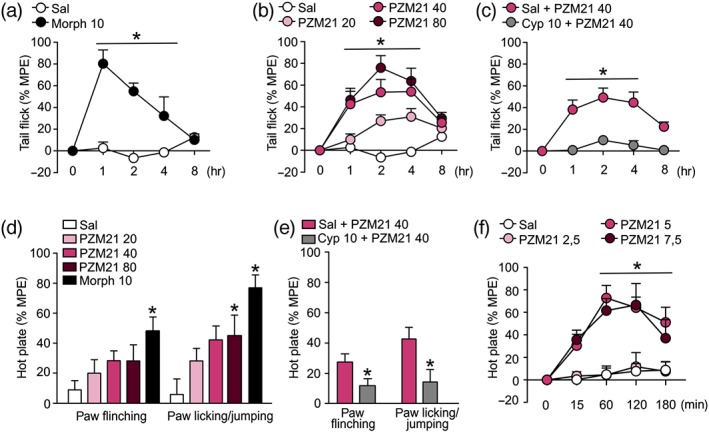Figure 1.

Effects of PZM21 on acute thermal antinociception. (a) Administration of morphine (10 mg·kg−1, i.p.), used as a positive control, resulted in an attenuated sensitivity to painful stimulus in the tail flick test (b) Treatment with PZM21 (20, 40, and 80 mg·kg−1, i.p.) caused dose‐dependent antinociceptive effect measured in the tail flick test. When compared to saline, the antinociceptive effect of 20 mg·kg−1 of PZM21 was statistically significant 2 and 4 hr after the drug administration, while treatment with doses of 40 and 80 mg·kg−1 of the compound induced antinociception that lasted from 1 to 4 hr after the treatment. Morphine and PZM21 groups are compared to the same saline controls. (c) A selective μ‐receptor antagonist, cyprodime (10 mg·kg−1, i.p.), administered 15 min prior to PZM21 (40 mg·kg−1), prevented antinociception in the tail flick test. (d) PZM21 had no effect on the paw flinching reaction in the hot plate test. However, at a dose of 80 mg·kg−1, it increased the latency to paw licking/jumping behaviour. Treatment with morphine significantly attenuated both types of reactions. Both responses were measured 90 min after drug administration. (e) Pretreatment with cyprodime attenuated the effects of 40 mg·kg−1 of PZM21 on both types of reaction in the hot plate test. * P < .05, significant effect of cyprodime. (f) Intrathecal administration of PZM21 (at doses of 5 and 7.5 μg) caused antinociceptive effects in the tail flick test in rats. Data are presented as the mean ± SEM. * P < .05, significant effect of treatment compared with appropriate controls. Numbers of animals used in experiments presented in Table S5. Cyp, cyprodime; MPE, maximum possible effect; Sal, saline
